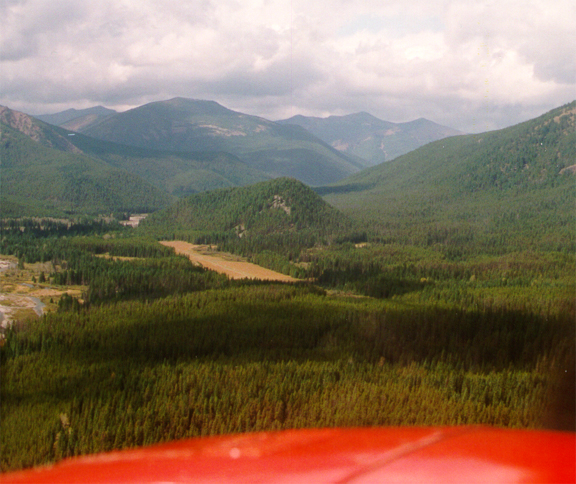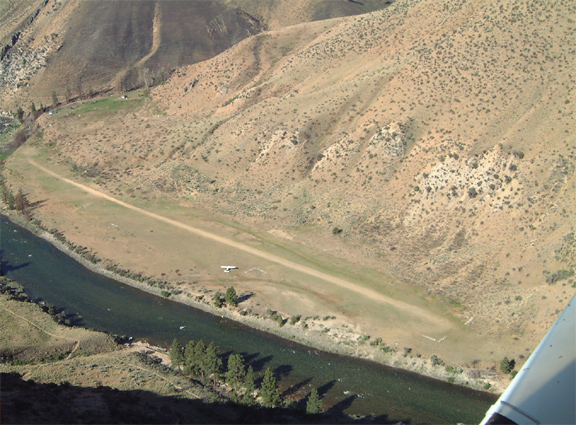Short-Field Operations
SHORT FIELD FLYIN’
(In one easy lesson)
By Howard “Short Field” Ballew
When you
fly the backwoods country
As I am prone to do,
You'd better know your airplane
And your own capabilities too.
When you're
landin' in a canyon
A one-way strip - 900 feet,
There's certain qualifications son,
You'd damn well better meet.
Know just
when your bird will stall,
Save a little for the flare,
Set up a real nice rate of sink
And bring 'er in right there.
It's “Seat
of the pants” flyin', son
So carry a little power,
Keep the engine warm, just in case
The whole thing does go sour.
You'll use
full flaps on final
Remember you can't go 'round,
Hit the end of the strip - dump the flaps - let 'er roll,
And jump out and kiss the ground!
As any good raconteur knows, you must capture the audience in the first paragraph of an article or you are up the proverbial aquatic tributary without means of motive power.
Short-field operations at backcountry airstrips differ from practice on a 5,000-foot-long airstrip. Often psychology enters the equation when the strip looks like nothing more than a cow path with heaves and swells, or when the airstrip is hidden so that you fly along a river or through a narrow canyon to sneak up on it, not seeing the actual strip until turning short final. Take that same strip and put it in an Iowa corn field and a student pilot might not have much problem with it; but put it in the mountains with a few obstacles and it becomes a real challenge … at least psychologically.

Big Creek, Idaho – landing to the south on runway 19 (nearest end in photo) means the airstrip disappears from view on the downwind leg and part of the base leg due to the hogback ridge.
As a “for instance” take a 2x4 and place it with the wide part on the ground. Now try to walk along the wood. Not much of a problem. But raise that piece of wood 20 feet in the air and it becomes difficult to navigate, even with a balance beam. It’s the same thing with some of the backcountry airstrips. You’ve got to get psyched up to land there.
When you plan to head for the backcountry and make some short-field landings, consider the following:
 Meadow
Creek, Montana
Meadow
Creek, Montana
Approach
Operations at an airstrip where you don’t see the strip from far out requires that you make some simple calculations. In the backcountry we don’t often use the 3-degree glide path; rather, a 4- to 5-degree approach angle provides better obstacle clearance and a better sight view for making timely glide path adjustments. If, for example, we decide to use a 4-degree angle, then we should be 400 feet above the runway at 1 mile from the threshold. If the airstrip cannot be seen until one-half mile out, you should be 200 feet above the runway. And if you can’t see the approach end until arrival on a one-quarter mile final, you should be 100 feet above the runway surface.
To achieve a 4.5-degree approach angle, multiply the ground speed (in knots) by 8 to obtain the rate of descent in feet per minute. While maintaining the approach airspeed, adjust the power to obtain the rate of descent and align the windshield mark with the aiming point on the runway.
Spot-method for landing
To arrive at an exact spot on the runway where you begin your flare as well as to eliminate visual illusions associated with sloping terrain and the convergence of lines, use the spot-method. The spot-method for landing requires a windshield mark, either making a physical mark on the windshield with a China pencil or developing a mental image of this point. This point is aligned with an aiming point on the ground where you desire to flare. Power adjustments, while holding the approach airspeed constant, are used to maintain the aiming point alignment. (See www.mountainflying.com for a complete explanation of the spot-method.)
Airspeed control
If I had to list only one problem that plagues students during a short-field landing it would be the lack of airspeed control. A mere 10-percent increase in approach speed equates to a 21-percent increase in landing distance. Ten percent might not sound like a lot, but where the normal approach speed is 60 knots, it takes only 6 knots to increase the landing distance substantially.
Density altitude
Pilots know about density altitude but become complacent or simply ignore this problem. I use about 1,100 feet of runway to takeoff in my Cessna 180J operating at gross weight (3,190 pounds) at 5,000 feet density altitude.
Under standard conditions the physical altitude and the density altitude are the same. But throw in a hot day and the picture changes dramatically, affecting not only the landing distance but also the takeoff distance and rate of climb once airborne.
 Airstrips
are often located next to rivers
Airstrips
are often located next to rivers
Tailwind Landings
Mountain airstrips are often located along side a creek or river. During the morning when the sun begins heating the ground, solar effect causes the air to rise and move up river (valley breeze) often causing a 4-6 knot tailwind for landing. This has the effect of increasing the landing distance about 20 percent.
Other Factors
Some other factors that require consideration for a short-field landing are the aircraft’s gross weight, the wind, the humidity, the runway surface (soft, wet, grass), the runway gradient and the pilot’s skill level.
Have fun and fly safely
|
|
|

